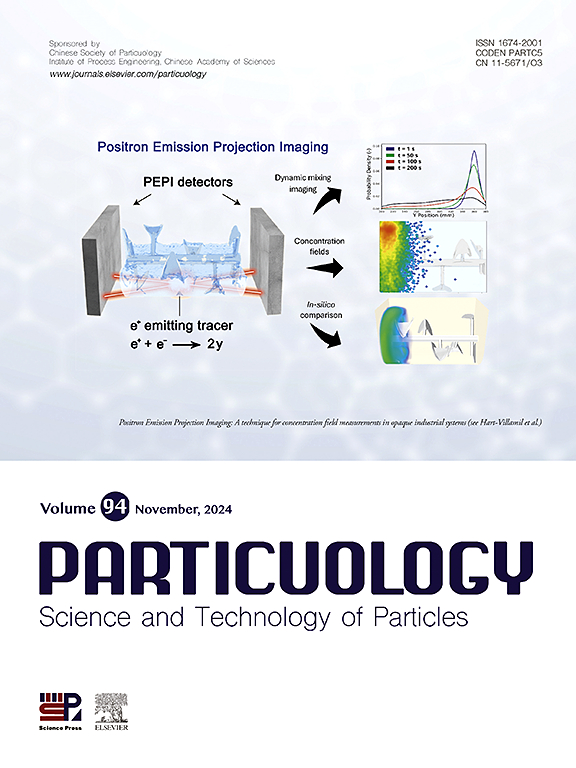Segregation mechanism of 0–1 mm fine coal in vibration separation fluidized bed and its influence on the fluidization stability
IF 4.1
2区 材料科学
Q2 ENGINEERING, CHEMICAL
引用次数: 0
Abstract
This study investigates the impact of mixing 0–1 mm fine coal with 0.15–0.3 mm magnetite powder to form a binary dense medium. The aim is to examine how the 0–1 mm fine coal influences the stability of vibration separation in a fluidized bed and to achieve steady-state control of vibration fluidization. The vibration segregation behaviour of the binary dense medium under varying fine coal contents is analyzed in this work. The study discovers that the primary contributor to segregation is coal particles smaller than 0.5 mm. As the proportion of fine coal increases, upward movement becomes more pronounced, especially for particles smaller than 0.15 mm, where the upward segregation is most noticeable, with a peak mixing index of 8.06. The study confirms that the larger the particle size of fine coal, the higher the content limit for mixing with magnetite powder. According to studies on the process of fine coal segregation, coal particles larger than 0.5 mm move with the magnetite powder, and the mixing index remains below 3. Coal particles smaller than 0.5 mm fine coal will separate at a uniform speed in a stable environment produced by low vibration energy, with the top-level mixing index remaining constant at 26 after 6 min. Additionally, the study also examines how the fluidization of vibration separation is influenced by the segregation of 0–1 mm fine coal. The evidence shows that longitudinal density segregation within the binary dense medium competes with instantaneous density fluctuation. The longitudinal density distribution of the binary dense medium was found to be nearly uniform when the frequency was set to 25 Hz, amplitude to 2 mm, and upward gas velocity to 1.4 times the minimum fluidization velocity. The density fluctuation was found to be between 0 and 0.1 g/cm3. The best separation effect was achieved with fine coal particles ranging from 6 to 1 mm in size under these conditions.

0 ~ 1mm细煤在振动分离流化床中的偏析机理及其对流化稳定性的影响
本研究考察了0-1 mm细煤与0.15-0.3 mm磁铁矿粉混合形成二元致密介质的影响。目的是研究0 ~ 1mm细煤对流化床振动分离稳定性的影响,实现振动流化的稳态控制。本文分析了不同细煤含量下二元致密介质的振动偏析行为。研究发现,产生偏析的主要因素是小于0.5 mm的煤颗粒。随着细煤比例的增加,向上偏析更加明显,特别是小于0.15 mm的颗粒,向上偏析最为明显,其峰值混合指数为8.06。研究证实,细煤粒径越大,与磁铁矿粉混合的含量限值越高。细煤偏析过程研究表明,大于0.5 mm的煤粒随磁铁矿粉移动,混合指数保持在3以下。小于0.5 mm的细煤颗粒会在低振动能量产生的稳定环境中匀速分选,6 min后顶层混合指数保持在26不变。此外,研究还考察了0-1 mm细煤的偏析对振动分选流化的影响。结果表明,二元致密介质中的纵向密度偏析与瞬时密度波动相互竞争。当频率为25 Hz,振幅为2 mm,向上气速为最小流化速度的1.4倍时,二元致密介质的纵向密度分布基本均匀。密度波动在0 ~ 0.1 g/cm3之间。在此条件下,6 ~ 1mm细粒煤的分离效果最好。
本文章由计算机程序翻译,如有差异,请以英文原文为准。
求助全文
约1分钟内获得全文
求助全文
来源期刊

Particuology
工程技术-材料科学:综合
CiteScore
6.70
自引率
2.90%
发文量
1730
审稿时长
32 days
期刊介绍:
The word ‘particuology’ was coined to parallel the discipline for the science and technology of particles.
Particuology is an interdisciplinary journal that publishes frontier research articles and critical reviews on the discovery, formulation and engineering of particulate materials, processes and systems. It especially welcomes contributions utilising advanced theoretical, modelling and measurement methods to enable the discovery and creation of new particulate materials, and the manufacturing of functional particulate-based products, such as sensors.
Papers are handled by Thematic Editors who oversee contributions from specific subject fields. These fields are classified into: Particle Synthesis and Modification; Particle Characterization and Measurement; Granular Systems and Bulk Solids Technology; Fluidization and Particle-Fluid Systems; Aerosols; and Applications of Particle Technology.
Key topics concerning the creation and processing of particulates include:
-Modelling and simulation of particle formation, collective behaviour of particles and systems for particle production over a broad spectrum of length scales
-Mining of experimental data for particle synthesis and surface properties to facilitate the creation of new materials and processes
-Particle design and preparation including controlled response and sensing functionalities in formation, delivery systems and biological systems, etc.
-Experimental and computational methods for visualization and analysis of particulate system.
These topics are broadly relevant to the production of materials, pharmaceuticals and food, and to the conversion of energy resources to fuels and protection of the environment.
 求助内容:
求助内容: 应助结果提醒方式:
应助结果提醒方式:


